Europe 1500 to 1700
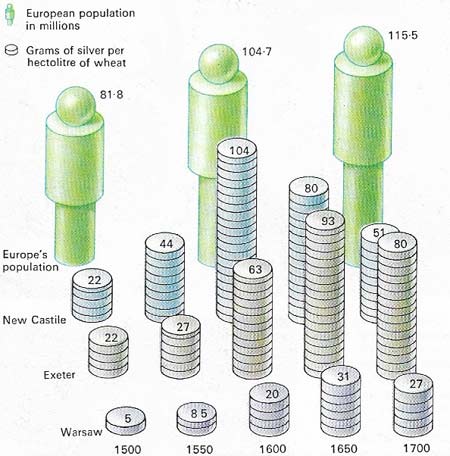
Figure 1. The rapid rate of inflation during this period (in which all food prices rose steeply) has no conclusive explanation. But population growth seems to have been a major factor.
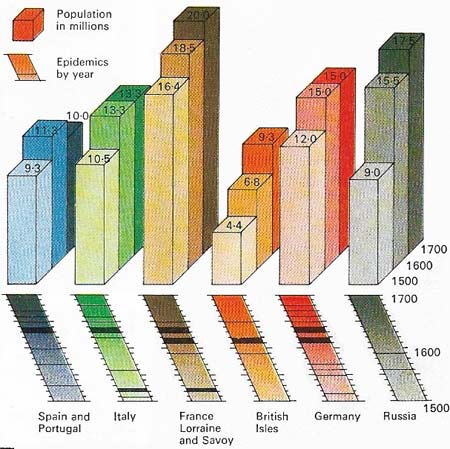
Figure 2. The growth of population during the sixteenth century was considerable. The growth of population during the sixteenth century was considerable. The increase seems to have begun around 1450 and become more rapid after 1500. The recurrence of plague and the long duration of European wars had, by the mid-seventeenth century, reduced the rate of growth once more. The diagram illustrates the changing population figures of the major European nations between 1500 and 1700.
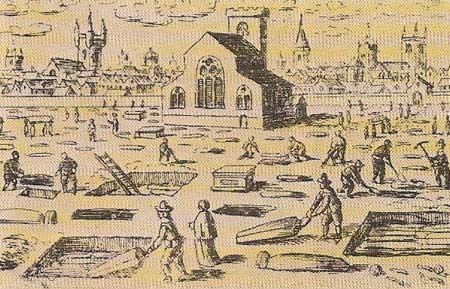
Figure 3. Death by plague had been common in Europe for almost two centuries. Periodic epidemics were a major check on population growth, but it is difficult to assess accurately the effects of plague on an age when routine diseases and accidents also made a significant contribution to the high mortality rate. Between a sixth and a third of the population died in each epidemic, although this figure could rise to as much as two-thirds, as happened in Germany in the 1630s. Plague also had some long-term effects; unstable social and economic conditions pushed up the age of marriage and thus lowered the birth-rate. Worst hit by the plague were the crowded, badly housed urban poor.
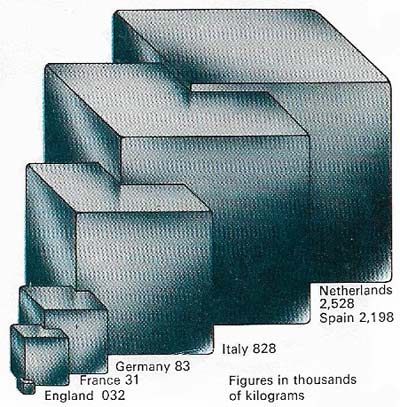
Figure 4. Silver mined on the New World and imported by Spain had a considerable influence on political and economic life on Europe. How Spain distributed this bullion between 1580 and 1626 is shown here. Spending in Spain and The Netherlands reflects the huge sums used for defense. The rest of Europe, learning from Spain, looked to trade to provide the wealth necessary for military power.
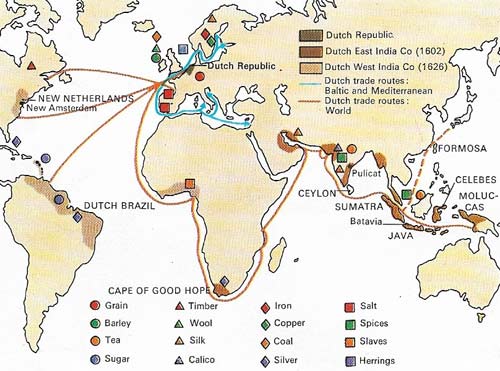
Figure 5. The Dutch held economic sway in Europe principally by carrying the products of other countries. The central areas of the carrying trade were the Mediterranean, the English Channel, and the Baltic. The East Indies were the source of spices and luxury goods for the resale in Europe. The West India Company had the more political aim of reducing Spanish trade by privateering.
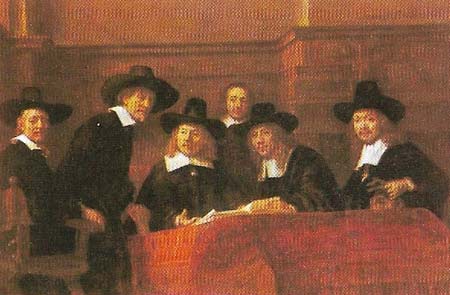
Figure 6. Wealth and culture went hand in hand during the golden age of Dutch art of the 17th century reflects the alliance, as in Rembrandt's celebrated portraits of wealthy Dutch merchants.

Figure 7. Venice was one of Europe's most important trade centers at the start of the sixteenth century. However, the wars on the early part of the century and the colonization of the New World shifted the focus of trade to Atlantic ports such as Amsterdam and Bristol.
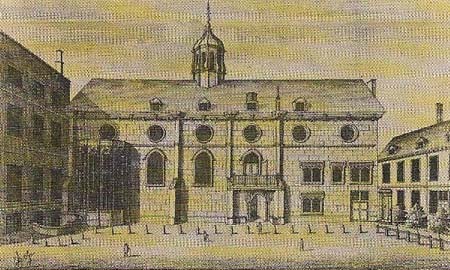
Figure 8. The growth of joint-stock trade over long distances gave rise to the need for more flexible instruments of credit and exchange. Significantly, the Dutch first broke from the tradition of raising money from private families such as the Fuggers, and the Bank of Amsterdam (shown here) was set up in 1609. The Bank of England, opened in 1694, was modeled on it.

Figure 9. Amsterdam, more than any other city, illustrates the revolution in the economic life of early modern Europe. During the 17th century the axis of economic activity shifted north – from a concentration of trade on the Mediterranean to a prevailing emphasis on Atlantic trade. As the center of the Dutch carrying trade, Amsterdam became a mart, a world bank and a center of insurance for traders.
In the first half of the 16th century the economy of Europe was dominated by a steady price rise; in the second, by unprecedented inflation. Price increases were felt first in Spain and resulted from the greatly increased imports of gold and silver from new mines in Mexico and Peru. The effects of this massive importation of bullion (Figure 4) were later offset by its export to other parts of Europe to liquidate Spain's unfavorable trade balances, to supply the needs of her armies in The Netherlands and by way of smuggling across the French frontier. Until these movements of bullion took effect general prices in the rest of Europe had risen more slowly than in the Iberian Peninsula.
Stimulus to international trade
This different rate of inflation in the European countries imparted a further stimulus to the expansion of international trade which had followed the discovery of the New World. The Baltic trade in corn with southern Europe, soon to be controlled and financed by the Dutch, was also promoted by the tendency of food prices to exceed those of manufactured goods. This was because an impressive growth in population in Europe (Figures 1 and 2) – from 50–60 million in 1450 to nearly 100 million in 1600 – increased the demand for foodstuffs when supply was restricted by poor yields in corn-producing areas of eastern Europe.
Although industry still catered mainly for the provision of luxuries to the wealthy, commercial expansion-led to a greater use of credit facilities and an extension in public banking, especially in Italy where Genoese financiers arranged the transfer of Spanish remittances to The Netherlands.
The Dutch "economic miracle"
In the 17th century many of these trends were reversed. Inflation was checked in the second decade by decreasing imports of bullion from the New World. International trade, buttressed by the defence requirements of the Thirty Years War (1618–1648), later experienced a downturn and stagnated. Competition between the powers for a preponderant share of world trade led to the adoption by most governments, except the Dutch, of mercantilism, a system of protectionist trade policies.
The shift of the center of commercial activity from the Mediterranean to the Atlantic seaboard, however, continued. The chief beneficiary, apart from England, was the Dutch Republic, which won virtual great-power status by its pre-eminence in the carrying trade, exploration, and finance. This "economic miracle", occurring in a period of general contraction, rested on Dutch control of the North Sea herring and the Newfoundland cod fisheries; on technical expertise in shipbuilding and insurance; on the elimination of the Portuguese from the Far Eastern spice trade and the Spanish from their monopoly of commerce with South America; on the international, exchange and credit facilities provided by the Bank of Amsterdam (founded in 1609) (Figure 8); and on the policy of toleration which induced the prosperous victims of religious persecution in Spain and France – the Sephardic Jews and Huguenots – to settle in Amsterdam (Figure 9).
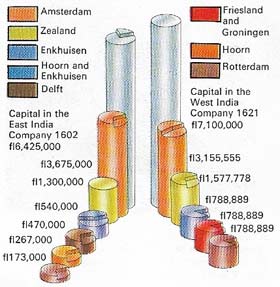 |
| Rich Amsterdam merchants provided most of the backing for the Dutch East India and West India Companies. Both were joint-stock companies on which there were many shareholders, thus dividing the risks as well as the profits involved on colonial trade. The diagram illustrates the sources of the capital invested in the two companies when they were originally formed. |
Economic and naval warfare between the Dutch Republic (the United Provinces of the northern Netherlands) and their main rivals, England and France, impaired Dutch commercial supremacy (Figure 5) in the late 1600s; it was finally undermined during the War of the Spanish Succession (1701–1714).
European society, 1500–1700
The society of early modern Europe was principally agrarian with 90 percent of the population deriving a living from the land. Farming was carried out under the jurisdiction of the manorial lord, although the farmer was also governed by various local customs. Inflation, however, was a social solvent that loosened the characteristic rigidity of 16th-century society where status was determined by law and not by wealth. The medieval concepts of a "just price" and a controlled economy also ceased to be valid. Until the end of the sixteenth century the pressure of population on the means of subsistence involved a fall in living standards and a decline in real wages.
The more volatile situation in the 17th century enabled the emergent middle classes to consolidate their wealth and to improve their social status. Generally the people who profited most were those who could charge higher prices without in turn having to pay them. These were the farmers whose tenure was secure and those noblemen who could evict their tenants and exploit the land. For those who were landless or whose title to their land was insecure, the real effect of the price rises was eviction, vagrancy and perhaps death by starvation. Because a smaller work force was needed for pasture farming many were condemned to a life of wandering as beggars. From the land-owners' point of view labor was relatively cheap and this helped to stimulate improvements in agricultural and manufacturing processes.
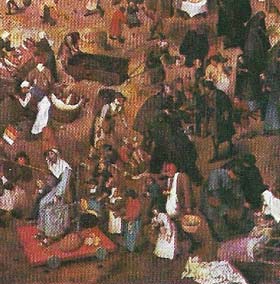 |
| In early modern Europe life was hard for the ordinary man, as depicted by Bruegel the Younger. Beggars were a common sight and for the laborer the holy days of the Church were the only respite from the burdens of his day-to-day existence. But the Church also ordained that periods of abstention from any work or indulgence must be strictly observed. Such decrees were often not followed; in Charles I's reign, Archbishop Laud (1573–1645) encouraged sports on the Sabbath. |
The seventeenth century saw the growth of mining, finishing industries (such as dyeing), tobacco-growing, and even market gardening. But the place of "manufacture" in this period was the cottage and not the factory; cloth was distributed piecemeal to be spun, dressed or dyed by rural laborers or farmers, whose living standards improved as prices tended to fall.
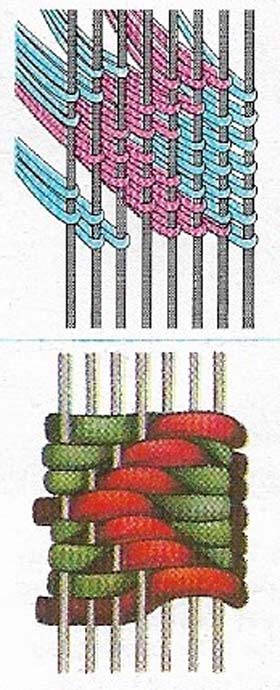 |
| Cloth was one of the most important 17th-century manufactures. Italian silk damask-weaving techniques of the 15th century (shown here) were taken to England from Flanders in the 16th century. |
